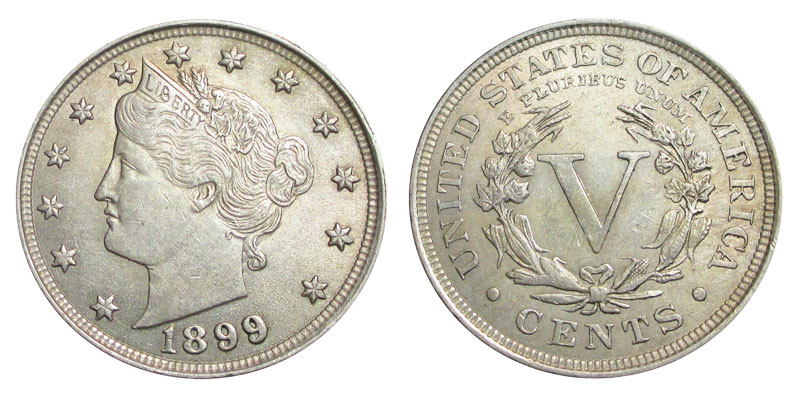Nickels
The Jefferson Nickel has been the longest running series for the five cent denomination. Featuring a portrait of Thomas Jefferson, the 3rd President of the United States, the design was introduced in 1938. This came after the introduction of the Lincoln Cent and Washington Quarter and represented the third series of American coinage to feature a former President on the obverse. During its long history, the Jefferson Nickel has undergone a temporary composition change and in recent years, a number of obverse and reverse design changes.
The original Jefferson Nickel was designed by Felix O. Schlag. A left-facing portrait of the former President is shown on the obverse with required inscriptions “In God We Trust”, “Liberty”, and the date. The reverse features an image of Jefferson’s historic home known as Monticello with inscriptions “E Pluribus Unum”, “United States of America”, “Monticello” and “Five Cents”.
Nickels is a nice arcade but small with only a few shops, most of which seem to be closed when I visit but I enjoyed the shops that were open and the great coffee at Comet too. Nice place so check it out which won’t take you long. Few nickels had circulated in the western states before the 1880s (people there preferred silver and gold coins); interest in the new Liberty Head design had led to increasing use of nickels there. Good economic conditions and high demand for nickels for use in coin-operated devices caused the piece to circulate throughout the nation by 1900.
- US Nickels – Get more than five cent's worth when collecting this integral decimal coin The Coinage Act of 1792 created the nation's first five-cent coin: a silver disme, or half dime. Much later, the Coinage Act of 1866 created a new five-cent coin. It was made of a copper-nickel alloy and called a nickel.
- 222.5k Followers, 596 Following, 33 Posts - See Instagram photos and videos from @nickels.
This same design remained in use without any significant changes for more than six decades. Then, a series of design changes took place from 2004 to 2006 to commemorate the bicentennial of the Louisiana Purchase and Lewis and Clark’s expedition through the vast territory. Over the course of three years, theWestward Journey Nickels would feature four different reverse designs before reverting to the original image of Monticello. The obverse would feature two new portraits of Jefferson, with the second serving as the replacement going forward.
Despite its lengthy duration, the series remains an approachable one for beginning collectors. It is entirely possible to find the earlier dates of the series in circulation and even an uncirculated set does not include any expensive key date coins. Advanced collectors can also find challenge in assembling a set of gem condition coins with well defined strikes, as represented by the appearance of “Full Steps” on reverse.
This site provides basic information on the series of Jefferson Nickels, including the designs, mintages, coin specification, and important issues of the series. We hope that both beginning and advanced collectors will find the site informative and educational.
Circulating Coins- Year of Issue: 1794 to Present
- Authorizing Legislation: Coinage Act of 1792

Background
The “Return to Monticello” theme is the current design of the U.S. five-cent coin. The U.S. Mint first issued this design in 2006. The obverse (heads) shows an image of Thomas Jefferson based on a Rembrandt Peale portrait. The image of Monticello on the reverse (tails) is a more detailed depiction of the design used from 1938 to 2003.
The first five-cent coin made by the U.S. Mint was silver, not nickel. This silver five-cent coin was called a “half disme” (pronounced “dime”) and was much smaller than today’s nickel. The designs from 1794 to 1837 featured Liberty on the obverse and an eagle on the reverse. In 1837, a wreath design replaced the eagle.
In 1866, the Mint produced new five-cent coins made of nickel and copper, which people called “nickels”. The Mint continued making the smaller silver half dime until 1873.
From 1913 to 1938, the Mint produced the iconic “Buffalo” nickel, designed by James Earle Fraser. The obverse showed the bust of a Native American chief, and the reverse depicted an American bison.
Jefferson took his place on the obverse of the nickel in 1938 with Monticello, his Virginia home, on the reverse. These designs, both by Felix Schlag, continued until 2003. In 2004, the Mint commemorated the bicentennials of the Louisiana Purchase and Lewis and Clark Expedition with the Westward Journey Nickel Series.
Other Circulating Coins:
Penny | Dime | Quarter | Half Dollar
Read MoreRead LessCharacteristics
Obverse (heads): Shows, since 2006, the Thomas Jefferson likeness based on a Rembrandt Peale portrait completed in 1800. Peale’s portrait was the basis for most of the images of Jefferson made during his lifetime.Reverse (tails):

 Features the classic rendition of Monticello originally made by artist Felix Schlag in 1938, but with greater detail and relief added in the dome, balconies, door, and windows.
Features the classic rendition of Monticello originally made by artist Felix Schlag in 1938, but with greater detail and relief added in the dome, balconies, door, and windows. Obverse Inscriptions
- IN GOD WE TRUST
- LIBERTY (in cursive, based on Jefferson's handwriting)
- Year
Reverse Inscriptions
- UNITED STATES OF AMERICA
- E PLURIBUS UNUM
- FIVE CENTS
- MONTICELLO
Nickels

Mint and Mint Mark
Specifications
| Composition | Weight | Diameter | Thickness | Edge | No. of Reeds |
|---|---|---|---|---|---|
Cupro-Nickel Balance Cu | 5.000 g | 21.21 mm | 1.95 mm | Plain | N/A |
Artist Information
Nickels Heels
Obverse
- Sculptor: Donna Weaver
- Designer: Jamie Franki, Artistic Infusion Program
Nickels And Dimes
- Designer: Felix Schlag